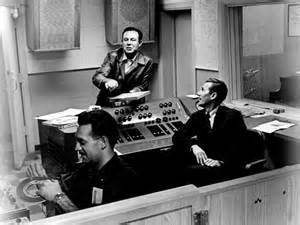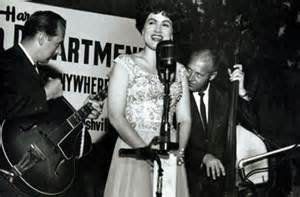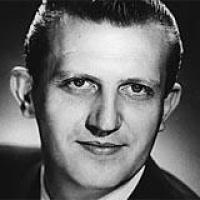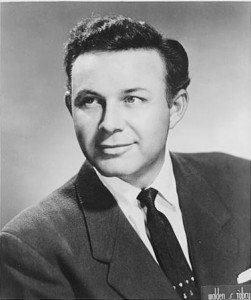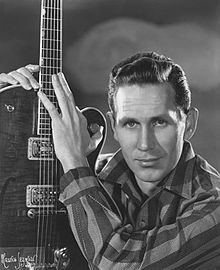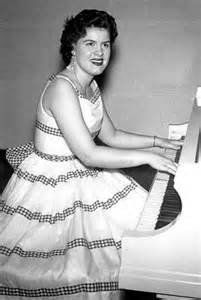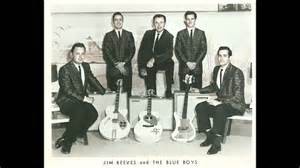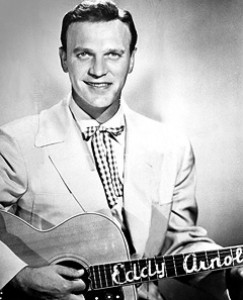Written by Lynden Orr, Abby Wills, and Madison Comstock. 25 February 2015.
In the late 1950s the emergence of rock ‘n’ roll pulled fans away from the country music industry, forcing Nashville producers to search for a sound that could appeal to the whole country and be profitable while still being country, and they found the Nashville Sound. Producers steered clear of the traditional honky-tonk sound in order to appeal to America’s large middle class. For the first time in country music’s history, hit songs climbed both the country and pop music charts, becoming crossover hits. Producers chose more sophisticated themes, elegant outfits, and refined the use of honky-tonk instruments like the steel guitar and the fiddle. At first this style was criticized for not being country, but with time it became clear that it was necessary to save country music.
Two pioneer producers of the Nashville Sound were Chet Atkins and Owen Bradley. Atkins is credited with creating the sub-genre, and he worked to appeal to the middle class by getting rid of country music’s blue collar roots, or the honky-tonk. Honky-tonk lyrics were rife with typical working class problems like alcoholism, failed marriages, and adultery. Many Americans didn’t want to hear about these things, and could escape them with the Nashville Sound. Producers brought in heavy string sections and backing vocals to make songs more sophisticated. They introduced the singing style of crooning, which established a more personal audience and singer relationship. The Nashville Sound kept the theme of heartbreak, without the angsty uncontrolled honky-tonk style of singing. Also, songs that were about traditional country elements evoked romanticized images of the Old West, such as cattle, cowboys, and horses, which were respectable. Under the guidance of Atkins and Bradley, a small group of studio musicians learned the new style and sound and played on almost every country album recorded in Nashville. This tight knit group of musicians created consistency in the Nashville Sound, so the sub-genre is easily recognized for it’s instrumentation. The technology at the time was limited and artists used tube microphones to record vocals. These mics gave a warm tone to the voice, which contributed to the artist’s sound but are no longer used today.
There were many critics of the Nashville Sound, and some people even called for boycotts of the music so that artists and producers would not continue prospering off a style that listeners deemed not country. At the center of the criticism is Nashville sound’s commercial success, crossover trends, and polish. For example, Chet Atkins referred to the Nashville sound as “a way to sell records and make money”. Others have argued that Nashville sound was a natural evolution of country music drives by social and economic factors. Some said that the Nashville sound was great music but that it took away authenticity and tradition and ultimately would result in an opposing style emerging.
______________________________________________________
Key Figures
-
Patsy Cline (1932-1963) had a smooth, deep, emotional voice that carried the Nashville Sound to many ears across America. One reason this new style was possible was artists like Patsy who had a pop voice but wanted to sing country songs. She wanted to be full on country, Loretta Lynn style, with boots, fringe and cowboy hats, but was swayed by producers to dress elegantly and sophisticated to match the style of music she was singing. Patsy is known for her emotion filled ballads, like Faded Love and Crazy; you can hear the sadness in her quivering voice. Her budding career was halted mid-bloom after a fatal plane crash. The legacy Patsy left country music was a handful of crossover hits that made listeners feel what she felt.
- Owen Bradley (1915-1998) a pianist and producer, played a chief role in defining the
Nashville Sound. He produced many famous country artists. Bradley combined Patsy Cline’s pop voice with a sophisticated country sound to create huge crossover hits. To create his sound he “cut out the fiddle and steel guitar and added choruses to country music”. Bradley was an advocate of constantly updating his style to keep fresh and adapt to music fans. He gave Patsy a sophisticated and elegant sound and image that allowed her to appeal to a wide range of audiences. Cline’s legendary hits “Crazy”, “I Fall to Pieces” and “Walkin’ After Midnight” were produced by Bradley. He was inducted into the Country Music Hall of Fame in 1974 and remembered most for being an architect of the Nashville Sound in the early 60’s.
-
Jim Reeves (1923-1964) was a singer songwriter of the early 1960’s who pioneered the Nashville Sound. Reeves’ style and vocals appealed to both country and pop music listeners. He dressed far more elegantly than other country music stars and was nicknamed “Gentleman Jim”. His sound was full and pleasing without the nasal vocals and yodeling often heard over the country radio at the time. With the help of producer Chet Atkins, Reeves topped both pop and country music charts with songs like “He’ll Have to Go” and “Four Walls.”
- Chet Atkins (1924-2001) helped create and produce the Nashville Sound in the early 60’s.
He is known as a guitarist and as the mastermind producer and sound engineer behind Jim Reeves. Chet helped redefine country music across America to “…broaden the appeal, and to keep making records different, to surprise the public.” His approach was influenced by market forces and was a clear commercialization of the genre. The sound he created was lush and warm, the image was polished and glamorous. It was important to Atkins that his songs evoked emotion and created strong ties with the listener’s feelings. His crossover hits didn’t always please audiences loyal to traditional country, but the sound he created has become an important staple in country music today.
These four figures were pioneers of the Nashville Sound. They may have been the faces of the new style, but behind them was a small group of studio musicians who perfected the sound. The studio guitarists, pianists, back up singers and other musicians used what they called the “numbers system” to play the music that these key figures used to create a new genre. This group of musicians and back up singers were a huge part of the creation of the Nashville Sound.
______________________________________________________
Recommended Listening
“I Fall to Pieces” by Patsy Cline. A very dramatic song about love and heartbreak. Patsy has been broken up with, and every time she sees him, she falls to pieces and is inconsolable, especially when he tells her to forget him. This is a good example of a typical Nashville Sound song in the lyrics, because a major theme of this genre was heartbreak. There are synthesizers present, and while the lush string sections that characterized the Nashville Sound are not as prevalent in this song as others, other elements are, such as the dramatic, sweeping background vocals, and Patsy’s voice is sophisticated, with barely a twang. This song is emotional, but what characterizes it as the Nashville Sound is how it is still sung in a sophisticated way, without the angst a honky-tonk song would have had.
“Cattle Call” by Eddy Arnold. This is the second usual type of Nashville Sound songs: a saga song, a song that evokes images and themes of the romantic Old West .This song is about a lonely cowboy who rounds up cattle and sings. The country described in this song is romantic and appealing to the whole country, including the middle class that the Nashville Sound was marketed to. Eddy Arnold sings with a slight, but not prominent twang. The musical arrangement is very pop oriented, with the only thing really making it country the lyrics. There is just a guitar that is audible, mostly the song is centered around his sophisticated voice. This song is a good example of a Nashville Sound saga song because it is about the romantic west, not the honky-tonk, and is still very pop and refined.
“Crazy” by Patsy Cline. This ballad style song is very bluesy, with a piano and other string instruments being the ones that are the most easily heard. She sings in a typical blues manner, not pop or country, and has a large vocal range. However, the instrumentation on the song definitely sounds more country than other songs of the genre with the slow, mellow pace. This is another song about heartbreak, with the man leaving her someone else and Patsy thinking she must have been crazy to think that just her love could keep him. This song was a huge crossover hit, reaching #2 on the Billboard Hot Country Singles, #9 on the Hot 100, and #14 on the U.K. Singles Chart, also being voted #85 on Rolling Stone’s 500 Greatest Songs of All Time List.
“The Blizzard” by Jim Reeves: This is another saga song about a cowboy, but again, an idealized one in that he is one of the romantic images of a cowboy that people picture when thinking of the Old West. It is tale of a man and his horse having a hard time traveling through a storm back home to his love and freezing to death, and Jim Reeves’s voice is soothing, refined, and very deep, and doesn’t really have a twang. He talks for awhile in the song also, a break from the ballad style of the rest of the song. The instrumentation is simple, with just a guitar softly playing, a break from the traditional use of the steel guitar of previous years and subgenres. This is another good example of a saga song because this is the American middle class’s vision of a cowboy, a romantic, wandering figure, paired with more pop vocals and pop instrumentation.
“He’ll Have to Go” by Jim Reeves. To be wooed by Jim Reeves low, encaptivating voice give a listen to He’ll Have to Go. This song is a story centered around a telephone conversation. As the song progresses, the listener learns that the man is near a jukebox and that the woman is with another man. Jim Reeves expertly sings in a lower range and uses more vibrato to create a smoother, more resonant and intimate sound. This approach works very well, giving the listener a focused point on the relationship and emotions. He’ll Have to Go reached No. 1 on the U.S. Billboard Hot Singles Country chart in 1960 and remained there for 14 consecutive weeks.
“Make The World Go Away” by Eddy Arnold. Widely regarded as one of Eddy Arnold’s best-known songs, Make The World Go Away is a great representation of the Nashville Sound. By 1963 Eddy Arnold had become a leading figure in the Nashville Sound era. The song includes “lush orchestral arrangements” and Eddy Arnold sings in a lower key so that his voice sounds full and resonant. This song touches on love and heartbreak, a classic theme in the Nashville Sound.
“Four Walls” by Jim Reeves. This song put Jim Reeves on the map. Four Walls was recorded in Reeves earlier RCA days. This song features his decreased volume, lower pitch, and singing with lips almost touching the microphone. Four Walls reached No. 1 on the Country Music charts and No. 11 on the Popular Music charts. The songs is about a lost love and how he is suffocated without this love. The song includes drums, piano, an electric guitar, and background vocals.
____________________________________________________
Annotated Bibliography
1. Arnold, Matthew. “Which way to the honky-tonk?”: An analysis of the Bakersfield and Nashville sounds. MA thesis. University of South Florida, Tampa, 2009. American Studies Commons. Web. 16 February 2015.
Arnold’s thesis is an analysis of the Nashville Sound, and the elements and artistry that distinguished it from other subgenres. As in other sources, Arnold traces the emergence of the Nashville Sound partially back to rock ‘n’ roll, which changed what a pop song should sound like an introduced the concept of crossing over. He writes about Chet Atkins, the producer who is credited with creating the Nashville Sound, and his desire to appeal to the large American middle class. To do this, he worked hard to get rid of country music’s working-class, or honky-tonk, roots. Atkins took out the steel guitars and fiddles and brought in “smooth vocal choruses, lush string sections, and the ‘round warm tones’ of hollow-body electric guitars” (32). He also softened the lyrics, because traditional honky-tonk lyrics were about working class problems, so these had to go to draw in an audience of middle-class Americans. This purity of tone that Atkins created made the Nashville Sound very profitable and country artists more respected and no longer a part of the hillbilly stereotype. Jim Reeves introduced the singing style crooning, which was a “softer style of singing designed to create a more personal relationship between the singer and the audience”, which was characteristic of the Nashville Sound, but he still had a slight country accent, keeping the country in the music (33). Some songs of the era had country themes, but they were a far cry from honky-tonk themes, and were sung without angst and extreme emotion. Overall, the Nashville Sound “can best be described as an effort to smooth over the edges of the honky-tonk sound” (32).
2. Brassington, David. “Jim Reeves 50 Years: On Remembering The Untimely Death Of A Legend.” Maverick 127 (2014): 48-50. Music Index. Web. 17 Feb. 2015.
Brassington discusses the fact that even past the untimely death of Jim Reeves his music lives on. His popularity reached a height in 1966, two years after his death, with his record “Distant Drums” staying at the top of the charts for several weeks (48). The article flashes back to the beginning of Jim’s career – as an announcer on the Louisiana Hayride. He soon started recording and in Nashville began working with Chet Atkins. Atkins “found Jim had a great deep baritone, so he got Jim to pitch his voice lower,” and Jim Reeves’s smooth voice, an essential element of the Nashville Sound, was discovered. Not only was Reeves’s voice rewired to fit in the style of Nashville sound, but his whole public image changed as well. Gone were the cowboy hats and the fiddle. There were many debates over how overly orchestrated the records were becoming. Many people opposed the Nashville Sound because they didn’t believe it was country enough. However, Brassington reminds us that it sometimes is all about the voice and goes to say that Jim Reeves had a “wonderful deep voice” (50). Although Reeves’s voice had been “rewired”, it remained country.
3. Collins, Tom. “The Nashville Sound with Tom Collins.” Telephone interview. 17 Feb. 2015.
Tom Collins, a very successful producer in Nashville, was a great primary source for researching the Nashville sound. He was friends with both Chet Atkins and Owen Bradley and he gave a great behind-the-curtain look into the lives of these famous producers. As a top Nashville producer himself, Tom knows his sub-genres. He’s produced many Countrypolitan acts like Barbara Mandrell and Ronnie Milsap. Tom was able to explain why the Nashville Sound became so popular and what it took to create its distinct sound in vocals and instrumentation. He explained the key role of studio musicians and backup vocalists who learned the Nashville Sound so well that they created a system of numbers that allowed them to easily communicate the exact sound they wanted. This small group of musicians played on almost every country album produced in Nashville around that time. They created a consistency in instrumentation that allows the Nashville Sound to be easily recognized. He also talked about the producers’ motives behind the shift from hillbilly to sophistication and what that meant industrially for country music. Tom explained that as a producer, one must have a desire to please the audience and keep music fresh and updated, but also focus on the market and revenue. This explains one of the motivations that spurred Atkins and Bradley to create the Nashville Sound. He explained the benefits of Nashville Sound’s respectability among disc jockeys. Cross over hits widely expanded the country music radio market. New country music radio stations that emerged brought income and national awareness and appreciation to country music.
4. Jensen, Joli. “Authenticating the Nashville Sound.” The Nashville Sound: Authenticity, Commercialization, and Country Music. Nashville: Vanderbilt UP, 1998. 118-134. Print.
Chapter 6 of the The Nashville Sound, written by Joli Jensen, gives insight into the style and acceptance of the Nashville sound. The chapter describes the early criticism of the subgenre even by its creator, Chet Atkins. It describes the loyal nature of the country music crowd and the difficulty fans had accepting crossover hits. Country songs that hit the pop charts were no longer considered country by the loyal traditional audience but at the same time had trouble finding a place on the radio. Jensen highlights country music’s pride in its non-commercial tradition leading to Nashville sound’s original obstacle with the country crowd: being too money-driven and trying to appeal to a pop fan base. (120) Jensen addresses the question of country music’s survival of rock ‘n roll from many angles. She both revokes and confirms the Nashville Sound saved country. Jenson claims that rock ’n roll stole young country fans, so to fill the gap they left, producers went after elite Americans by dropping the corny hillbilly sound. This was a move to save the country music industry, not necessarily the style of the genre. The chapter points out the shift away from steel guitar and fiddle to violins and strong vocals. Another argument for the Nashville sound Jensen addresses is the new style as a needed growth and creative movement of the genre as a whole. (122) The word “craftsmanship” was used to describe the sophistication of honky tonk. The Nashville Sound had a tough job in gaining the trust of country music listeners and the respect of disc jockeys and the urban listener. (126) The redefinition of country music as authentic and heartfelt allowed it to shed the hillbilly image and become a music for the American people. (128)
5. Kienzle, Rich. Album notes. Nashville was the roughest. Willie Nelson. Bear Family, 1998. CD
In this book, Kienzle, a music journalist and critic, discusses the struggles Willie Nelson faced trying to make a career with the Nashville sound for eight years, a style that didn’t quite suit his voice. Chet Atkins, a producer who pioneered the Nashville sound, tried to sell Nelson to a wider audience by integrating his uniqueness into the usual trends. Harold Bradley, a guitar and brother of Owen Bradley, said “We couldn’t record him as a hit artist here in Nashville” (1). The author shares many of Nelson’s attempts at recording albums catered to the Nashville Sound style. During the years with Atkins or Felton Jarvis producing, a total of 15 singles charted, and only two of them broke into the ‘Billboard’ country Top Twenty (4). Those eight years would make Willie frustrated and confident that he could produce better records for himself than anyone in Nashville could (4). The only place that Willie succeeded was in Texas. Willie hopped on the Outlaw movement, which gave him a chance to show this true talent free from the producers (45). Willie Nelson’s successes in the Outlaw Movement had been developed and shaped by his earlier work in Nashville sound. Many of the concepts that made Willie successful took root at RCA.
6. Neal, Jocelyn R. Country Music: A Cultural and Stylistic History. New York: Oxford University Press, 2012. Print.
Jocelyn R. Neal writes about the development and characteristics of the subgenre of country music Nashville Sound. The chapter concentrated on this subgenre states that while the Nashville Sound is greatly different than the traditional country that came before and after it, it is still country because of various musical elements. Though the singers were much more refined, they were still country artists that saved country music from being taken over by Rock n’ Roll. Neal emphasizes that the instruments played in songs did not change, only their usage did, with the steel guitar “[blending] smoothly into the accompaniment” instead of standing out prominently like it does in honky-tonk music, and the fiddle being played in a more sophisticated way and being called a violin (195). Similarly to other sources, Neal talks about the two usual types of Nashville Sound songs: either heart wrenching love songs or songs that evoked images of the Old West and cowboys. She also touches on the commercialism aspect and the fact that Nashville Sound grew out of rock ‘n’ roll, calling it “an unfortunate but necessary moment of selling out to commercial interests in order to save country music,” in that country music needed to be made popular to the masses once again after being passed over by a genre as profitable and popular in youth culture as rock was (216). Neal discusses all of the aspects of the Nashville Sound that we talk about in a thorough analysis of the subgenre.
7. Pecknold, Diane. The Selling Sound: The Rise of the Country Music Industry. Durham: Duke University Press, December 2007. Print.
The Nashville Sound was a result of the rockabilly movement of the previous decade: many rockabilly artists recorded their hit songs in Nashville, because there were strong elements of country music in rockabilly songs. This influence made Nashville a legitimate recording city, and created the reputation of being “the place” for country music recording and producing. The production and distribution structure formed by this rockabilly phase enabled the mass production of country music that appealed to the whole country by being marketed to a new sector: middle class adults. This middle class was white and the rural-to-urban migrants who moved from the South and Midwest to urban centers and achieved economic success. The country music industry used this economic success to challenge the hillbilly stereotype of the country music fan, saying that because they weren’t dirt-poor that it was a more sophisticated audiences, which meant the beginning of the Nashville Sound. The Nashville Sound brought country music closer to pop and produced crossover hits. There was a large shift by most artists, with some instances of resistance, towards a smoother sound characterized by backing vocals, lush string arrangements, and more polished singing styles. Many people across the country hated this new sound coming from Nashville, claiming that it wasn’t even a subgenre- it was just a marketing strategy. Traditional country music fans staged protests, with some calling on DJs to not play Nashville Sound records because the artists who recorded them needed to know that people wouldn’t listen to their songs unless they had elements of traditional country people were used to. In the end, this book deals with the commercialism and marketing of the Nashville Sound and how it developed, as well as the backlash associated with it, not so much the sound of the music itself.
8. Streissguth, Michael. Eddy Arnold: Pioneer of the Nashville Sound. New York: Schirmer, 1997. Print.
Streissguth, a professor and music journalist, has written a number of books about country music. In this book, Streissguth focuses on how Eddy Arnold developed in his country music career and his impact on Nashville Sound. As he explains, with the emergence of rock ‘n’ roll and Elvis Presley, Eddy Arnold had a hard time producing hits. Before this point Eddy Arnold was a huge deal. He even had his own TV show. Eddy starting working with Chet Atkins, a producer at RCA, and they perfected his voice, which melded well with the new instrumental environment (154). This was Arnold’s first encounter with what was becoming the Nashville Sound. Eddy was one of the pioneers of the Nashville Sound. During his Nashville Sound career Eddy Arnold switched managers to Jerry Purcell. Purcell felt that Chet Atkins and RCA Nashville failed to find the best songs for Eddy (165). While Eddy was successful with the Nashville Sound, Jim Reeves was having infinitely more success. Eddy managed to get two hits in 1959, but Reeves spent “fourteen weeks at number one” (167). Bill Walker arrived in Nashville just as the sudden death of Jim Reeves occurred. Walker worked on musical arrangements for Arnold, adding a new twist to Eddy’s adaptation of the Nashville Sound. Walker doubled the typical number of string instruments and added an oboe, clarinet, and saxophone to the instrumentals, constructing the largest Nashville ensemble to back up Eddy. Eddy blazed a path through country music that’s recognizable today. Eddy’s desire, Jerry Purcell’s management, and Chet Atkins’s producer skills all came to represent the Nashville Sound and its ability to appeal to the masses.
______________________________________________________
Guiding Questions
- What was one motive behind the creation of the Nashville Sound?
- Why might it be hard to recreate the Nashville Sound today, with modern technology and musicians?
- List three ways in which the Nashville Sound was made to sound more sophisticated than the existing Honky Tonk music?
- What are the advantages and disadvantages of a song that crosses over into more than one genre?

